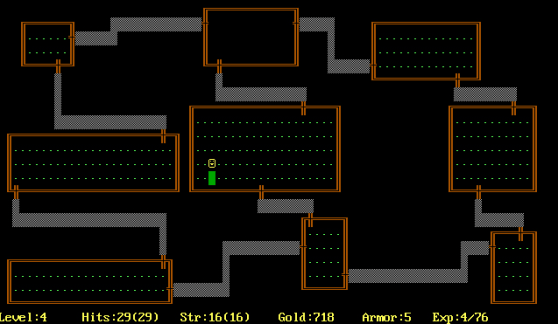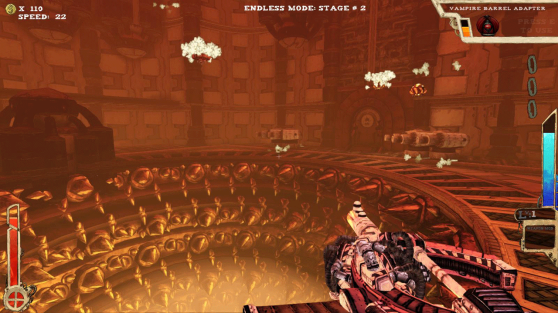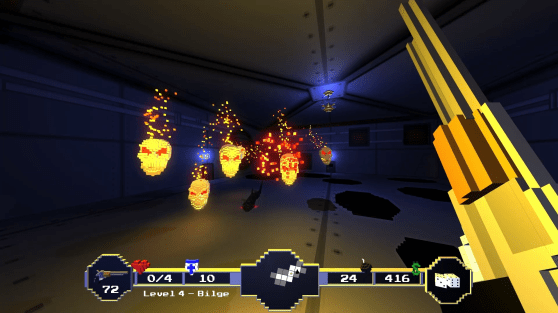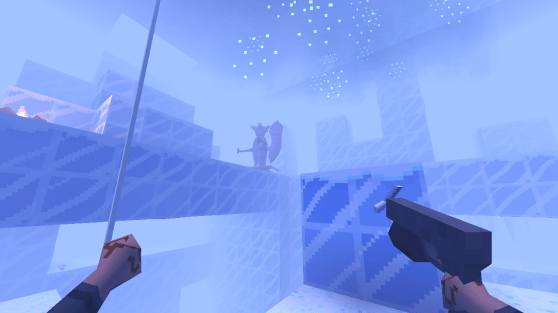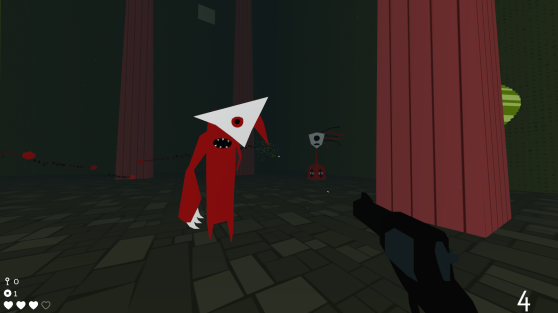Your favorite first-person shooters aren’t hard enough. That’s why the world needs roguelike FPSes.
The roguelike FPS (or roguelike-like games, a ridiculous moniker if one ever existed) takes a traditional shooter and adds elements from roguelike role-playing games. The subgenre has exploded on PC, with several indie developers releasing projects in the past year.
The RPG type has been around for decades, but a half-dozen developers say they had the same idea at nearly the same time in just the past couple of years. What if you took a roguelike and applied its elements to a shooter, instead?
Drop the things from the genre that aren’t commonly found in FPS games, such as turn-based gameplay, the fantasy setting, the tile-based graphics. Keep what makes the RPG games brain exploders, such as the permadeath — no revives for you — and the random levels. You end up with a shooter that is fiendishly difficult and fun to both program and play.
“You have to be active instead of passive to enjoy these games, you know? Interested and curious,” said Terri Vellmann, the developer of Devolver Digital’s Heavy Bullets, a roguelike FPS that launched recently for $10 on Steam and Humble. “And usually you have to enjoy a challenge. The constant deaths can be a turn off for some people.”
Take a super-difficult RPG and add a gun
The roguelike genre’s name comes from the original 1980 RPG Rogue and usually includes conventions that were part of that experience: permadeath, computer-generated levels that rebuild differently each time you die and start over, unidentified items, time pressure, sprite-based and tile-based graphics, turn-based gameplay, and a high-fantasy setting.
Those RPGs are hard, thinkers’ titles, with high replay value because of the randomly generated maps and challenges. Even the items your character receives are often random.
Heavy Bullets gives you death, bright, beautiful colors, and six rounds of ammo
The newest entry in the roguelike FPS game, Heavy Bullets offers neon-colored, blocky animation filled with the core elements of the genre. In addition to permadeath and random levels, it adds the element of inventory management.
You can only carry six bullets at a time while retrieving and reloading bullets after you use them. That’s a challenge when multiple enemies are throwing themselves at you with increasing speed around corners you’ve never seen before. See for yourself:
My own experience playing Heavy Bullets started by navigating a maze of hallways strangely overgrown with neon-colored plants. I saw an enemy — a coal-colored blob with big, white teeth — and coolly fired. I then got jumped by an alligator-shaped plant and defended. Two more beasties attacked, and I barely got the second before my screen flashed with damage. In the next set of rooms, I was attacked by three or four, failed to see one, fired my remaining shots wildly and died. Rinse and repeat. (I consider myself a competent, but not outstanding, player of traditional shooters.)
Easy to play, easy to die — and hard to put down
Joe Mirabello explained the reasoning behind new new FPSes. He’s manager and sole developer at Terrible Posture Games, which released the Tower of Guns roguelike FPS in March. It’s $15 on Steam and other sites.
“It’s a core design philosophy difference,” he said. “Something like Tetris is ‘easy to learn, hard to master.’ Roguelikes instead are ‘easy to play, easy to die, hard to learn, hard to master.’
“All those secondary mechanics — the randomization, the absurd varieties of enemies and items and situations, those are there to help make learning how to play the game into something fun. I tried to capture that attitude with Tower of Guns by treating the player’s own familiarity with the rules as a progressing element in the game.
“I also tried to design the game as if I were 8 and needed to put spikes on everything and fill the sky with 200 bullets. That turned out to be pretty fun, too.”
He’s not kidding about the bountiful bullets:
One roguelike leads to another
Vellmann said Heavy Bullets started as a standard FPS, but then, RPGs influenced its development.
“I was playing mostly Spelunky and Binding of Isaac and was really interested in how their systems worked. When it was time to think about the levels in [Heavy Bullets], it just seemed like the way to go.”
The indie randomly generated action adventure games inspired the developer to create a game where the levels were generated by machine, not developer. Spelunky is a 2D, detailed side-scrolling game following a cave adventurer; Binding of Isaac is a top-down game following Isaac’s battles with monsters in his basement.
“I like that it requires less planning and more play testing and refining. It’s also cool that the game will catch you off guard or that something unexpected will happen while you’re play testing.”
Vellmann credits Paranautical Activity with proving that roguelike FPS titles could work.
Suddenly, it’s a party
Michael Maulbeck is the lead designer and programmer for Paranautical Activity at Code Avarice. The game is in beta now and will release Oct. 17 on Steam and other locations for $10. It offers a variety of classes and weapons in a blocky Minecraft-style FPS. He said the sub-genre expanded quickly.
“When we started working on Paranautical Activity, there weren’t any other roguelike FPSes — none that we knew of, at least. Within a few months of development, we met lots of people working on similar projects,” he said. “It was pretty wild to see that we all had more or less come up with the same idea at the same time.”
Maulbeck said he was also inspired by playing The Binding of Isaac.
“Pretty much all my game ideas are ‘I wish X was an FPS.’ So when I started watching Binding of Isaac ‘Let’s Plays’ on YouTube, I immediately made the connection and had to do it.”
He started with random levels and permadeath while adding time management as a factor after reading up on the roguelikes, he said. Now, if you don’t clear levels in a certain amount of time, an unkillable ghost comes to chase you down.
Several developers also mentioned Minor Key Games’ Eldritch as an influence. The early roguelike first-person action game (with shooting elements) hit Steam last fall for $15 for Windows, MacOS, and Linux, and has received substantial updates twice this year, most recently in August.
David Pittman, a cofounder and developer at Minor Key Games, credits Spelunky on the roguelike side and Deus Ex and Dishonored on the FPS side for his inspiration to create the project.
“When I started designing Eldritch, there weren’t as many roguelike FPSes on the market to look at. I found some inspiration in the unfortunately titled ManDoom, a mod of the original Doom, which adds the essential roguelike flavors of permadeath and random map generation.”
A genre that makes it easy for small developers
The new structure is perfect for indie developers, Pittman says, because it allows them to focus on the concept rather than level building.
“First-person games are my bread and butter. I never ever considered doing something else. But as an independent developer with limited resources, I couldn’t afford to make a game with the broad scope of contemporary FPSes,” Pittman said.
“Procedural level generation made the most of my time by extrapolating a few hours of level design work into a near-infinite set of maps.”
What’s next: Triple-A studios, genre mashups, and … zombies?
With the steady stream of indie games in the genre now on the market, most developers said they expected to see some interest in the genre from mainstream studios.
“I think there is interest in roguelikes of all sorts, and I think this genre will flourish and evolve,” said Alexander Tequibo, developer of the roguelike FPS Fancy Skulls ($9 on Steam). The game offers traditional RPG elements in a fast-paced shooter with an interesting paper-cutout graphic style, and has been cited by other developers as an influence on the genre.
“A simple mashup of these mechanics isn’t novel anymore, so I predict we’ll either see iteration and polish on this blend to make better results or perhaps further mashing with other genres or subgenres,” Tower of Guns developer Mirabello said.
Heavy Bullets’ Vellmann has a suggestion for what kind of mashing might be fun.
“Someone should make a horror-FPS roguelike. It would be awesome.”
I’m frantically squirreling away my undead-killing bullets now.
VentureBeat's mission is to be a digital town square for technical decision-makers to gain knowledge about transformative enterprise technology and transact. Learn More

